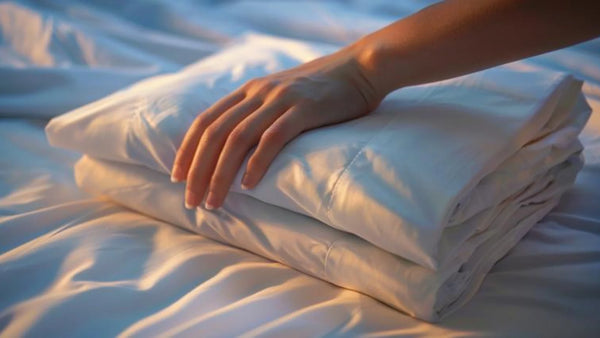Key Takeaways
silk is a precious natural fiber from the cocoons of silkworms, while cotton satin is a specific weave giving a smooth and shiny appearance to the cotton. Although different, these two textiles offer softness, elegance and many benefits for the skin and hair. Choosing between silk and satin will depend on your preferences in terms of feel, care and budget.
The French brand The Oversized Hoodie® 🇫🇷 is famous for its textile expertise, particularly its collection of high-end, 100% natural mulberry silk products certified Oeko-Tex® Standard 100.
Free from toxic and chemical substances, and ecological, the collections silk pillowcase, silk sleep maskand silk scrunchie stand out for their incomparable softness and excellent value for money, providing an unrivaled feeling of comfort.
Introduction to Silk and Cotton Satin

You are hesitating between silk and cotton satin for your bed linen, your clothes or your accessories ? We understand your dilemma. These two exceptional textiles are renowned for their incomparable softness, their luxurious appearance and their beneficial properties. However, there are notable differences between silk, this natural fiber rare and precious, and satin which is in reality a weaving technique that can be applied to different materials such as cotton.
In this article, we will explore the origins, characteristics and benefits of silk and cotton sateen. We will guide you to choose the textile best suited to your needs and give you all our advice for maintaining them. Whether you're looking for silky sheets, an anti-frizz pillowcase, a flowing shirt or a shimmering scarf, you'll know everything you need to make your choice between these two marvels!
Definition and Origin of Silk
silk is a natural protein fiber secreted by silkworms to form their cocoon. Discovered in China more than 4,500 years ago, its production requires great expertise. silkworms are fed exclusively on mulberry leaves before weaving their cocoon into a long continuous filament that can reach 1500 meters.
This silk thread, consisting mainly of fibroin and sericin, is then unwound and woven to give birth to this unique fabric. Light, resistant, insulating and thermoregulating, silk has an incomparable feel and a natural shine. A symbol of luxury and refinement, this noble textile is prized for making clothing, bed linen and accessories high-end.
Also read: How to recognize real natural silk ?
Definition and Origin of Cotton Satin
Unlike silk, satin is not a material but a specific weaving technique. Its name comes from the Chinese city Quanzhou, formerly called Zayton, famous for its weaving workshops since the Middle Ages.The satin weave is characterized by long floats (unbound threads) and rare binding points, creating a smooth and shiny surface on the right side, with few rough edges.
This method of weaving can be applied to different fibers such as silk, wool, cotton or even materials synthetics. cotton satin is thus obtained by weaving cotton threads mercerized according to the satin weave. More affordable than silk, it offers remarkable softness and shine while retaining the properties of cotton: breathability, resistance and ease of maintenance.
Importance of the Choice of Material for Household Linen
The choice of textile is crucial for household linen, in particular bedding which is in direct contact with the skin. Opting for natural, soft and breathable materials such as silk or cotton satin is a guarantee of comfort and well-being.
Beyond the aesthetic appearance and silky feel, these exceptional fabrics offer numerous benefits. They preserve the skin's hydration, limit irritation and allergies, and prevent the formation of wrinkles. For hair, they reduce friction, frizz and breakage. Finally, their thermoregulatory capacity promotes quality sleep in summer and winter.

I remember a customer, Marie, who contacted us a few months ago. She was looking for the perfect gift for her mother's birthday, a silk lover. Hesitating between our silk and cotton satin pillowcases, Marie asked us for advice.
After carefully listening to her needs and her mother's preferences, we recommended our luxurious 100% natural mulberry silk pillowcase. A few days after receiving her order, Marie contacted us again, delighted. Her mother was enchanted by the incomparable softness and shine of silk.
She told us that she had never slept so well! It’s this kind of customer experience, combining product expertise and listening, that pushes us to surpass ourselves every day at The Oversized Hoodie®.
- 1.08 W/m.K: this is the thermal conductivity of silk, much lower than that of cotton (1.55) or linen (1.53). This means that silk is an excellent thermal insulator, keeping you warm in winter and cool in summer. [1]
- 22 mommes: this is the weight of 100% natural grade 6A mulberry silk used by The Oversized Hoodie® for its high-end pillowcases, a guarantee of softness, resistance and quality. [2]
- 2,000 years: that's when the technique of weaving satin would have emerged in China, before being taken up in Europe. An ancestral know-how which partly explains the cost of this delicate textile. [3]
Invest in sheets, pillowcases or duvet covers in silk or cotton sateen is therefore a wise choice for your well-being and beauty. You still need to know how to differentiate them and determine which one will best meet your expectations. Let's now discover in detail the properties of each of these exceptional textiles.
Also read: Silk or Satin for the Skin: Which One to Choose ?
Comparison between Silk and Cotton Satin

Properties and Benefits of Silk
silk is a fiber with unique properties, prized for millennia for its incomparable softness, lightness and resistance. Made up of natural proteins, in particular fibroin rich in amino acids, it is hypoallergenic and respects even the most sensitive skin.
Its smooth and homogeneous structure limits friction and the adhesion of bacteria, making it a textile of choice for people prone to allergies or acne. silk naturally regulates temperature and humidity, providing a feeling of coolness in summer and warmth in winter. It absorbs up to 30% of its weight in water without giving the impression of humidity.
As for beauty, silk is a precious ally for the skin and hair. Its soft, slippery surface limits the formation of fine lines and wrinkles caused by nighttime friction on the pillow. It maintains the hydration of the epidermis and stimulates the production of collagen for smoother and radiant skin when you wake up.
For hair, silk reduces frizz, breakage and tangling. It preserves keratin and limits moisture loss for shiny, silky hair. Sleeping on a pillowcase in silk is particularly recommended for curly, frizzy or weakened hair.
Finally, silk is a guarantee of timeless luxury, refinement and elegance. Its natural shine and unique feel make it an exceptional textile for high-end clothing, accessories and household linens . Despite its high price and delicate maintenance, it remains a durable and valuable investment.
At The Oversized Hoodie®, we are committed to selecting the finest and most skin-friendly materials for our collections. Silk and cotton satin are among our favorite textiles for their incomparable softness, their thermo-regulatory properties and their natural shine. We work closely with ethical and sustainable silk and cotton producers to offer you exceptional products, combining quality, comfort and elegance.
— Geoffrey, Founder of The Oversized Hoodie®
Also read: Silk or Satin for Hair ?
Properties and Benefits of Cotton Satin

cotton satin is an interesting alternative to silk, offering similar properties at a more affordable price. Thanks to its specific weaving technique, it has a smooth, shiny and soft surface, close to that of silk. The long, mercerized cotton threads used to make it give it strength and durability.
Like silk, cotton satin is soft and silky to the touch, limiting friction and irritation of the skin. It is also hypoallergenic and breathable, letting the skin breathe while absorbing moisture. Its smooth surface prevents fine lines and wrinkles caused by facial pressure on the pillow during the night.
For hair, cotton satin is as beneficial as silk. It reduces frizz, tangling and breakage, especially for curly or textured hair. Sleeping on a pillowcase in satin allows you to wake up with smooth, shiny hair, effortlessly.
cotton satin is easy to care for, and can be machine washed at a moderate temperature unlike silk. It dries quickly and wrinkles easily, for a flawless appearance every time. Resistant and durable, it maintains its softness and shine wash after wash.
Aesthetically, cotton sateen brings a touch of elegance and refinement to bedding, clothing and accessories. Its shiny and luxurious appearance makes it a popular choice for special occasions such as a wedding or a night out. Less expensive than silk, it remains a quality textile for everyday use.
Also read: How to Choose between Silk and Satin Sheets ?
Characteristics Comparison Table
| Silk | Cotton Satin | |
|---|---|---|
| Material | Natural protein fiber | Mercerized cotton threads |
| Weaving | Various armor | Satin weave |
| Touch | Soft, smooth, fluid | Soft, smooth, slightly less fluid |
| Appearance | Brilliant, shimmering | Glossy on one side, matte on the other |
| Breathability | Excellent | Very good |
| Thermoregulation | Excellent | Good |
| Hypoallergenic | Yes | Yes |
| Maintenance | Delicate, hand wash | Easy, machine washable |
| Sustainability | Very good if well maintained | Excellent |
| Price | High | Affordable |
Also read: How to Recognize Genuine Satin ?
Tips for Choosing between Silk and Cotton Satin

Factors to Consider for Your Purchase
To choose between silk and cotton satin, several factors must be taken into account depending on your needs and preferences:
-
The touch: silk is unmatched for its softness and fluidity, but cotton satin offers a similar feel at a lower cost.
-
Usage: for daily use, cotton satin is more practical and durable. silk will be reserved for special occasions or delicate pieces.
-
Care: cotton satin is easy to machine wash and iron, while silk requires hand or dry cleaning and gentle ironing .
-
The budget: silk is a significant investment, justified for exceptional pieces.cotton satin offers excellent value for money.
-
Aesthetics: silk has an inimitable shine and shimmering colors. cotton satin is also elegant with its shine on one side and its matte appearance on the other.
-
Properties: both textiles are beneficial for skin and hair, with a slight advantage for silk in terms of thermoregulation and softness.
Our experience at The Oversized Hoodie® has taught us that the choice of textile is crucial for the well-being and satisfaction of our customers. Whether silk or cotton satin, we strive to offer hypoallergenic, breathable and durable products, which preserve softness and shine wash after wash. We rigorously test each item to ensure an optimal user experience and unparalleled comfort, night after night.
— Geoffrey, Founder of The Oversized Hoodie®
Also read: Why is silk expensive ?
Recommendations Based on Usage (Bedding, Clothing, etc.)

Here are our recommendations depending on the use you wish to make of silk or cotton satin:
-
For bedding (sheets, pillowcases, duvet covers): cotton sateen is an excellent choice combining softness, resistance and ease of maintenance. Opt for silk if you're looking for ultimate luxury and don't mind maintenance.
-
For clothing (shirts, dresses, pajamas): silk will provide incomparable fluidity and refinement for special occasions. In everyday life, choose cotton satin, more resistant and easy to wear.
-
For accessories (scarves, night masks, hats): the two materials are adapted according to your tastes. silk will be softer and more precious, cotton satin more affordable and easy to maintain.
-
For hair (pillowcases, turbans, bonnets): silk and cotton satin are both beneficial. silk will be a little softer and slippery, but satin is excellent value for money.
Don't hesitate to combine the two materials according to your desires and your budget. For example, you can choose sheets in cotton satin and fall for a sublime shirt in silk for a special event.
Also read: What is the best material for your pillowcase ?
Care and Durability of Silk and Cotton Satin Linen
To preserve the beauty and softness of your silk or cotton satin items, proper care is essential. Here are our tips:
-
Silk: prefer cleaning by hand in cold water with a special silk detergent. Avoid wringing, roll in a towel then dry flat. Iron at low temperature on reverse side. If necessary, opt for dry cleaning.
-
Cotton satin: machine wash at 30-40°C with a mild detergent, without fabric softener. Avoid spinning too intensely. Dry flat or tumble dry on low heat.Iron on the reverse side to preserve the shine.
In both cases, avoid contact with aggressive products (bleach, fabric softener, perfume) and excessive friction. Store your delicate items in breathable fabric covers, protected from light.
Properly cared for, silk can last for decades, increasing in value over time. cotton satin is also very durable, being able to withstand numerous washes without losing its quality. With proper care, it will accompany you for many years, while remaining soft and silky.
Also read: What are the Advantages and Disadvantages of Silk ?
Conclusion
In summary, silk and cotton satin are two exceptional textiles which offer softness, shine and numerous benefits for the skin and the hair. silk, a precious natural fiber from silkworm cocoons, is an unrivaled luxury product, thermoregulating and hypoallergenic. cotton satin, the result of a specific weaving technique applied to mercerized cotton threads, is a more affordable and easy-to-maintain alternative, while maintaining a silky feel and similar properties.
To make your choice, consider your budget, the intended use (bedding, clothing, accessories), your preferences in terms of touch and maintenance. Both materials are ideal for taking care of your skin and hair, bringing you softness and well-being on a daily basis as well as during your nights.
| Characteristic | Silk | Cotton Satin |
|---|---|---|
| Textile | Silk | Cotton Satin |
| Origin | Natural fiber from silkworm cocoons | Cotton woven with satin technique |
| Touch | Very soft, smooth, luxurious | Soft, smooth, shiny |
| Usage | Clothing, bed linen, high-end accessories | Clothing, bed linen, daily accessories |
| Maintenance | Delicate, hand wash | Easy, machine washable |
| Price | High | Affordable |
Don't hesitate to combine silk and cotton satin as you wish: sheets in satin, a pillowcase in silk, a sublime satin pajamas for a glamorous look... The possibilities are endless to introduce a touch of refinement and softness into your life.
So, silk or cotton satin ? It's up to you to choose according to your needs and your favorites. One thing is certain, you will no longer be able to do without these exceptional textiles which will enhance your nights and your outfits. Let yourself be tempted by the incomparable softness of silk or the brilliant charm of cotton satin, for moments of pure happiness and delicacy.
FAQ
Is cotton satin good for hair ?
Yes, cotton satin is excellent for hair. Its smooth and soft surface limits friction and breakage, reducing frizz and tangles.Sleeping on a pillowcase in satin allows you to wake up with shiny, silky hair, especially for curly, frizzy or weakened hair.
What is the silkiest fabric ?
silk is undoubtedly the silkiest fabric, thanks to its natural fiber with unique properties. Its softness, fluidity and shine make it the most luxurious and sensual textile. silk satin offers a close feel, followed by other types of satin such as cotton satin or polyester satin .
What is the difference between satin and cotton satin ?
satin is a specific weaving technique creating a smooth and shiny surface, which can be applied to different materials (silk, cotton , polyester). cotton satin is obtained by weaving cotton threads mercerized according to the weave of satin. It is therefore to be distinguished from the more luxurious silk satin, or the less noble polyester satin, synthetic material.
Silk or satin sheet ?
The choice between sheets in silk or in satin will depend on your preferences in terms of feel, thermoregulation and care, as well as your budget. silk will offer unrivaled softness and freshness, but requires delicate maintenance. cotton sateen will be more affordable and easy to maintain, while retaining a silky feel and similar properties.
Curly hair silk or satin pillowcase ?
For curly hair, a pillowcase in silk or satin is ideal. Both materials limit friction and breakage, preserving the shape of curls and reducing frizz. silk will be even softer and more slippery, but cotton satin offers excellent value for money and is still very beneficial for curls.
Satin or silk for sleeping ?
Both silk and satin are perfect for sleeping, offering softness, freshness and many benefits for the skin and hair. silk will be the ultimate choice for luxury, thermoregulatory and hypoallergenic sleep. cotton sateen is an excellent alternative, more affordable and easy to maintain, to enjoy silky and comfortable bedding.
Silk or satin for the skin ?
silk and satin are both beneficial for the skin, limiting friction, irritation and the formation of wrinkles. silk, thanks to its natural proteins, is particularly recommended for sensitive skin. It maintains skin hydration and stimulates collagen production. cotton sateen offers similar benefits, to a lesser extent, at a lower price.
References
[1] "Physical properties and applications of silk", PandaSilk
[2] "100% natural mulberry silk pillowcase", The Oversized Hoodie®
[3] "Satin in 10 facts: definition, advantages, disadvantages", Journal des Femmes






